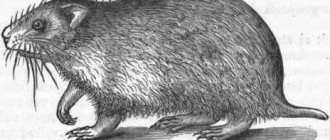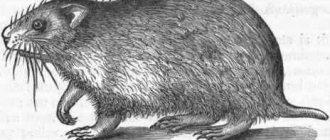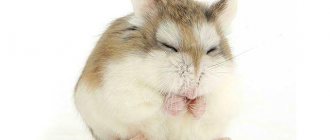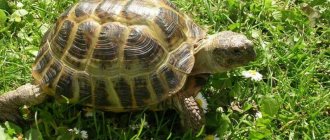Description and lifestyle of a Syrian
The Syrian hamster (Mesotricetus auratus) is one of the most famous breeds.
Sometimes they are also called the Western Asian or golden hamster. Breeders mostly call them simply Syrians, or jokingly “cubs” because of the resemblance. They have gained popularity among lovers of small pet rodents due to their unusual color. Like most of their relatives, Syrian hamsters are nocturnal. This is not a dwarf breed, but a quite normal-sized animal. If it bites, it will hurt.
Interesting fact: Syrians are the only breed that can learn to respond to their name.
Syrians have high (by hamster standards) intelligence and a calm disposition. They tolerate communication with humans very easily and are not particularly worried about life outside their natural habitat. These undemanding hamsters were first domesticated in America, where Professor Aharoni brought them from Syria. This is why they got their name.
Interesting fact : all domesticated Syrian hamsters trace their ancestry to this small group.
Where does the Syrian hamster live in the wild?
The wild brothers of your domestic Syrian lived, as the name suggests, mainly in Syria. These hamsters were found in Israel or other states bordering Syria.
In the photo: portrait against the backdrop of nature.
Now, thanks to Professor Aharoni, they live almost all over the planet - in Europe, North and South America, partly in areas of Asia and Africa. Well, maybe only in the Arctic there are none, but this is not certain.
Interesting fact : in the wild, Syrians can eat their offspring for the sake of survival.
This is interesting
The largest hamster in the world
. The common hamster is considered not only the largest, but also the most beautiful among its fellows. Its size is truly impressive. An adult reaches 25–30 centimeters in length. It has an extremely bright, rich red coat color on the back, a black belly and three white spots on the side of the head, chest and sides. The nose and paws are white. Although sometimes there are individuals of black and white or black color.
The smallest hamster in the world
. Among all domestic hamsters, Roborovsky's hamsters are the smallest. They reach only five to six centimeters in length. Their back and head are yellow-sand in color. But the belly and fur around the antennae are almost white. A distinctive feature of this breed of hamsters are light, almost transparent “eyebrows”. The movement of these funny animals across their territory is so rapid that their owners can mainly only observe their beloved pets. In addition, this type of hamster is characterized by increased nervousness, and moving them in the external environment or changing the environment becomes real stress for them, which can last up to several weeks.
Some hamsters may begin to chew on the cage or objects in it, and this can be corrected by giving the hamster cookies or putting chalk in the cage. Dog treats are good - they will not harm the hamster's teeth, nor are they harmful to health or digestion. But it is very important that the hamster has food or objects with which he can grind his teeth - if this is not the case, the constantly growing teeth can puncture the jaw.
Hamsters see in black and white, but at the same time they have very poor eyesight. Hamsters rely primarily on hearing and smell.
The Vietnamese authorities have banned the keeping of hamsters, rightly considering them carriers of dangerous diseases. The reason for such measures was the massive import of animals that had not passed veterinary control from abroad, which was associated with the onset of the Year of the Rat according to the eastern calendar and an increase in demand for small rodents. The maximum fine for violating the ban is 30 million dong, which is about 57,000 rubles, and is comparable to the annual income of a resident of this country.
What does a Syrian hamster look like?
Syrian hamsters are famous for their large size for domestic rodents. It can stretch up to 20 centimeters, with females growing larger. Adults usually weigh about 115-140 grams. There are heavyweights reaching the 200 gram mark, but this is rare.
The eyes of the Syrian hamster are black, but with a white color they are red. The muzzle is rounded, the paws and ears are small. It is distinguished by thick fur, which is why its tail is almost invisible. It has 4 toes on its front paws and 5 on its hind paws. Within the breed, they are divided into 4 subgroups based on coat type, but we will tell you about that too. Adult males have longer fur. Males have 2 nipples, females have 4.
Types of hamsters
Mother with offspring, Campbell's hamster photo can be enlarged
Syrian hamster
. This animal has a thirteen-centimeter stocky body with short legs, round ears, a round face, beady eyes and a small tail that can barely be seen under its thick fur. The rodent's belly is light, and its back is ocher-gray or brownish-gray in color. The hamster's hind paws have five toes, and the front paws have four toes and a vestigial fifth toe. In nature, this rodent lives in shallow burrows and is active at night. The hamster uses cheek pouches to transport materials for nest construction and food. The most common color of a rodent is considered to be golden, a natural color. The lifespan of a Syrian hamster at home is approximately three years.
The main component of the Syrian hamster's diet in captivity is grain food, in addition to which it is recommended to give crunchy treats that not only give him pleasure, but also bring great benefit by grinding down his ever-growing incisors. In addition to solid food, the diet of this rodent must include apples, pears, carrots, pumpkin, zucchini, turnips, radishes, and persimmons. It is recommended to feed the Syrian hamster no more than twice a day, in the morning and evening. In this case, the pet must be given such an amount of food that the rodent can leave a small part of it for the next day. This is explained by the fact that an animal’s need for food depends on the individual properties of its body. It is strictly forbidden to include citrus fruits, sunflower seeds, nuts, any oils, lard, fish oil, cabbage, yogurt, kefir and chocolate in the Syrian hamster's diet, the consumption of which will have a negative impact on his health.
Newborn hamsters photo can be enlarged
To keep a Syrian hamster at home, the most ideal option is a cage measuring 40 cm x 60 cm, which should be equipped with: Bedding
, for which you can use pressed sawdust of medium size fractions, which absorb moisture well and perfectly absorb odors.
It is strictly forbidden to use cotton wool, napkins, rags and newspapers as bedding. A toilet
for small rodents with a special absorbent material that is used as a filler.
A wheel
with transverse protrusions and a bottom without a grid, which is selected taking into account the size of the individual.
Lazas
, which can serve as roots, branches and tubes.
A drinking bowl
with a volume of fifty milliliters, the water in which is recommended to be changed daily.
A house
that can be attached to the wall of the cage.
A feeder
with a width of three to ten centimeters, which must be selected taking into account the size of the rodent.
When breeding Syrian hamsters, it is necessary to take into account that the female must be at least four months old, and the male must be at least three months old. Pregnancy in a hamster lasts for eighteen days, and the number of young animals in one litter ranges from four to fifteen individuals, which are fed with mother's milk for twenty-eight days. Before giving birth, it is recommended to completely disinfect the cage, and for childbirth to use a glass one-story cage measuring 40 cm x 25 cm. Newborn young animals are prohibited from stroking, touching or touching with hands, because the female, sensing a foreign odor, can eat her offspring. During pregnancy, as well as breastfeeding, it is necessary to separately and in small quantities include protein foods in the female’s diet, such as low-fat cottage cheese, boiled egg yolk, and boiled chicken.
Hamster cage photo can be enlarged
Djungarian hamster.
This is a popular small pet, measuring up to 5 cm in height and weighing up to 45 grams. This type of rodent has hairy feet, a dark stripe on the back and a very short tail, which is often practically invisible, especially when the animal is sitting. The fur is distinguished by significant white patches. Distributed throughout the dry steppes and semi-deserts of the south of Western Siberia, Eastern Kazakhstan, and Khakassia.
Djungarian hamsters are easy to keep at home, but require careful care. Compared to them, Syrian hamsters are more unpretentious. For example, a cage for a Djungarian hamster should be quite spacious, since the animals are very mobile. The Djungarian hamster also needs a chalk stone to grind down its teeth. When feeding Djungarian hamsters, it is necessary to take into account their predisposition to diabetes, so it is better to exclude foods rich in monosaccharides, which are found in vegetables, fruits and honey, from the diet.
It is not recommended to keep more than one hamster of this species in one cage, as these rodents are very territorial and show aggression towards each other in a confined space. When kept together, Djungarian hamsters live in a state of permanent stress, and in fights they can injure each other, even killing each other
Domesticated Djungarian hamsters often differ from wild ones in color. But all Djungarian hamsters have a narrow dark stripe on their back. The following types of color are distinguished: standard (brownish-gray, white belly), sapphire (gray-bluish, white belly), pearl (matte white with gray intervals), tangerine (red-cream).
Hamster wheel photo can be enlarged
In their natural habitat, Djungarian hamsters breed from March to September, but in captivity they breed all year round. A litter can have from 1 to 9 cubs. A month after birth, they must be separated and separated by gender. Puberty occurs at 4-6 weeks, but there are opinions that such an early pregnancy can be dangerous for the female. It is recommended to start mating at 4 months. The duration of pregnancy for the female of this hamster is 18-22 days. pregnant and lactating females should be provided with calm, comfortable living conditions, since in case of stress, the female can kill and eat her offspring. The female can also show aggression towards the male. The female is ready for fertilization again within 24 hours after giving birth, so the male must be removed immediately.
Roborovsky's hamster
It is not for nothing that it is called the dwarf hamster, since it is the smallest of the domestic hamsters. He has a short tail that almost does not protrude from the fur. The dwarf hamster has a snub-nosed muzzle and rather large, rounded ears, black in color with whitish trim. There are small white spots above the eyes. The back of the Roborovsky hamster is covered with pinkish-fawn fur, the belly and paws are with pure white fur, the soles of the paws are densely lowered.
Dwarf hamsters inhabit sandy deserts overgrown with caragana. These rodents feed mainly on the seeds of beets, caraganas, solyankas, sedges, cereals, and tulips, but insects and other invertebrates play a secondary role in their diet. These hamsters are active mainly at dusk and at night. The shallow burrows they dig in the sand consist of 1-2 passages and a nesting chamber. The breeding season is extended and begins in early May and ends at the end of September. During the season, each female brings 3-4 litters with 3-9 cubs in each. Young animals from the first litters begin to bear offspring already at the end of summer in the first year of life.
Another version of the photo cage can be enlarged
It is not difficult to create living conditions and care for dwarf hamsters. It is better to keep them in a small metal cage, at the bottom of which a layer of sand 2-3 cm thick is poured. Several stones are also placed here, as well as hay, moss, small and thin branches. A small box for the nest, in which the animals rest and feed their offspring, is also required. Sand should be changed as it becomes dirty.
Roborovsky hamsters, like other types of hamsters, need to be fed a variety of foods. The diet should include seeds of wild and cultivated plants, such as millet, sunflower, vegetables and fruits, greens - dandelion leaves or lettuce. In addition, oatmeal and white bread soaked in milk should be given. Sometimes hamsters should be fed mealworms. During the period of mating and raising young animals, animal protein should be given in abundance, which is necessary for successful reproduction and normal development of the offspring.
To breed dwarf hamsters, you only need to keep one pair in a cage. You should not keep a male and two females, since with this ratio the females usually do not get along. Sexual maturity in a young female occurs early, at the age of 2-3 weeks, on average at 19 days. Although there is also later maturation, when hamsters begin to reproduce only at 3 months. Perhaps this is a result of different conditions in captivity.
The duration of pregnancy is 19-22 days. Babies grow very quickly, fur appears by the end of the first week and at the age of 10 days it already reliably protects the animals from the cold, but their eyes open only on the 13th day. At 3 weeks of age they become independent and can be separated from their parents. And by this time the female is preparing for a new nesting, and if the older offspring are not removed, they continue to suckle the mother and, being stronger, push away the younger ones. As a result, newborn animals are delayed in development and may even die from malnutrition.
Multi-tiered cage photo can be enlarged
Brandt's hamster
or Transcaucasian hamster. A small rodent of the hamster family. The specific name is given in honor of the German zoologist Johann Brandt. The body length is from 15 to 18 cm and the tail is from 2 to 3 cm. The length of the foot is 16-26 mm. Ear height 10 - 24 mm. The weight of this animal ranges from 42 to 296 g. The animal has small, rounded ears. The natural color of the fur on the upper body is earthy brown. The belly is brownish-gray; on the chest between the front legs there is always a black spot that extends onto the shoulders. This hamster has a yellowish-red head on the sides, elongated black spots below the ears, and a white chin. White paws with bare soles. All the fur is smooth and soft, and only on the tail it is much thicker.
The Transcaucasian hamster is widespread in Turkey, Israel, Lebanon and also in the Eastern Ciscaucasia. Also inhabits the mountainous and foothill parts of Transcaucasia and Western Asia. In the south it is distributed in the Talysh Mountains and in the north-west of Iran, in the north, in Dagestan, it is found south and east of the river. Sulak. In Transcaucasia, its range extends east from the Arsian and Likh ranges, in all steppe and mountain-steppe landscapes of Southern Georgia and Armenia. It is found in the altitude range from 300 to 3000 m above sea level. m. Mainly lives in mountain steppes. Inhabits areas of grass-wormwood steppe on mountain slopes, mountain meadows and lands cultivated by people. Avoids damp and damp places.
Leads a predominantly nocturnal lifestyle. He is a loner by nature. In nature, life expectancy is about 2 years. For the winter it goes into hibernation at the end of October - beginning of December, and awakens in March - beginning of April. The duration of hibernation most often does not exceed 5 - 6 months, but can last up to 10. During hibernation, he sleeps from 2 to 7 days, after which he wakes up and stays awake for up to 2 days; often the sleep phase can last longer, up to 30 days.
Brandt's hamster burrows consist of a main horizontal passage, a small number of vertical burrows extend from it, and only one leads to the surface. The sloping exit is usually covered with earth. The nest of this animal is dug at a depth of about 2 m. For the winter, the hamster collects impressive reserves of grain in the hole. It feeds on green parts, seeds and tubers of all kinds of plants, and does not shy away from agricultural crops.
Syrian hamster colors
The most common color of Syrians is golden or sand. The fur on the belly is usually lighter than on the back. The ash-black color was accidentally developed in France. But this is a real rarity. Such hamsters are not found in the wild. The color comes in both a combination of shades and one color.
Basic colors of Syrians:
- sandy golden;
- soft cream;
- snow white;
- misty pearl;
- brownish yellow;
- blond;
- black;
- ash gray;
- honey;
- chocolate;
- ginger;
- red;
Types and colors.
The true color of the Syrian hamster is red, more like a mahogany shade. It was this kind of inhabitant that was first discovered in Syria and brought to Europe. Its peculiarity: gray ears and black eyes. With age, the color of the animal changes, the undercoats become grayer, but the golden hue of the top remains the same. There are other colors of the animal:
- The black by deep charcoal hair color, white paws and chin. It appeared in France in the process of mutation.
- The white animal has red eyes and gray ears.
- The color “ivory” is very similar to white, but has a distinctive feature. A milk hamster can have either black or red eyes.
- The gray animal has dark gray ears, stripes on its cheeks, and a gray spot on its chest. The coat itself is light in color with dark tips. The undercoat is blue.
As a result of mixing, other shades were obtained:
- Honey
- Smoky
- Blue mink
- Yellow
- Cream
- Chocolate
- Brown
- Beige
Syrian hamster Blue mink
Syrian Hamster Brown
Syrian Hamster Yellow
Syrian Hamster Beige
Syrian hamster Smoky
Syrian hamster Honey
Syrian hamster Cream
Hamster can be spotted. Currently, the Angora breed has been bred to have long fluffy hair.
Syrian Hamster Coat Types
Wild representatives of the Syrian breed had only short hair. This is due to their habitat: the warm climate led to the preservation of short-haired individuals in the population. Since the time they were domesticated, breeders have managed to obtain and secure 4 types of wool:
- Shorthair is a classic type of coat, characteristic of most rodents, so we will not dwell on it.
- Long-haired - representatives of the long-haired type have thicker and longer hair. This is especially true for males - the length of their fur can reach 10 centimeters. Long-haired ones look scruffier and get dirty faster, but they look funnier.
- Rex is a newly developed coat type. Syrian hamsters with this type of coat are very different from others: they have curly and dense fur, similar to sheep (not my type, I don’t really like curly dogs, cats, and now rex hamsters... I don’t understand. But the taste and color...)
- Satin - they can be confused with shorthair if you don’t know about their division into 4 types of wool. The satin type is a beautiful glossy sheen on a short coat. At the same time, in order for the offspring to retain this distinctive feature of the coat, Syrians of this color cannot be crossed with each other. Their fur will lose its shine and get dirty faster.
Look at the photo! Here he is, this long-haired guy. Well, isn't he handsome? It’s true that fur care needs constant care.
Photo of a Syrian with standard hairiness. Regular shorthair. But still beautiful!
And here is a photo with curls.
Life expectancy of a Syrian hamster
Syrian hamsters have a high life expectancy. Good immunity protects them from most diseases. Under normal conditions, it allows them to live for 3-4 years. The longest living Syrian hamster lived 6.5 years. How to properly care for your furry friend so that he lives longer, read in this article.
Interesting fact : Syrians are very humane. They love to communicate with their owners and can sleep in their arms.
Reproduction
Syrian hamsters reach sexual maturity at the age of 1-1.5 months, but at this time the growth and development of the body has not yet ended. The first placement of a male with a female is carried out when the pets are 4-6 months old. The duration of pregnancy is approximately 16-19 days, breastfeeding is 3-4 weeks, after this time the children can be separated from their mother.
After giving birth, the hamster should recover within 2-3 months, and only after that can pregnancy be planned again, so about 4 litters occur in 1 year. If this indicator increases, the health of the female may deteriorate, and the offspring will be born weak.
After one year of life, the ligaments of the pelvic bones become inelastic, and the animal loses the ability to give birth. Thus, in her entire life, a hamster is capable of giving birth 3-5 times , but it is worth remembering that Syrian hamsters are prolific and can give birth to 6-12 babies at a time, and sometimes up to 18.
Determining the sex of the hamster
It is almost impossible to determine the sex of the cubs; sexual characteristics become clear at the age of 2 months. If the male is laid on his back, large testicles can be seen.
In general, there are no particular differences in the behavior of the animals, but many owners have noticed that males smell less and make contact with humans more easily than females.
Syrians don't like stress
Care and maintenance of Syrian hamsters at home
One of the positive features of Syrian hamsters is their cleanliness. They are very responsible about personal hygiene and do not make a mess in their habitat. Caring for and keeping a Syrian hamster at home will not cause any special problems. The list of rules for his comfort is quite short. They do not require much effort to perform and will prolong the life of the hamster.
What you need to properly keep a Syrian hamster:
- the cage should be spacious;
- feeding with quality products;
- daily change of water to clean;
- absence of sharp loud sounds;
- odor-absorbing bedding;
- regular checks with a veterinarian;
- cleaning the cage once every 2 weeks;
- cannot be washed or bathed;
Periodic walks around the apartment will be very useful for the animal. At the same time, there should be no cats or dogs in the house. Because of them, the Syrian will constantly experience stress and all the benefits of walking will be lost. It is also advisable to accustom young animals to contact with people from childhood. Tamed Syrians can even fall asleep in the arms of their owners. An animal sleeping in the arms of its owner is an indicator of the rodent’s low stress level. As you can imagine, this is very good.
In order for the Syrian hamster to feel psychological comfort, you need to regularly spend time with it. Don't leave your hamster unattended for weeks as it will have a negative impact on him. Syrians love a large selection of toys - toys from pet stores especially for rodents and various cardboard boxes. For Syrians, the sanctity of sleep is important. You should not pick them up if they are not awake. You should not add cagemates to the animal, even if they are related by breed. Syrian hamsters are loners; they instinctively protect their territory from outsiders. This also applies to females - they should be housed together only during mating. Although the Syrians are not particularly aggressive, they can start skirmishes in defense of their territory.
Rodent color
Special attention should be paid to the international system of distribution of rodents according to their color. With age, the color may change, as a rule, it darkens.
Types of colors:
- Golden;
- Cream;
- White;
- Smoky pearl;
- Yellow-brown;
- "Blond";
- Black;
- Dark grey.
The golden rodent always has gray small ears and black bangs. The hamster wears this coat color for about 8 months from birth. After this period, his underfur turns gray. The top hairs remain golden.
The most common color is cream. As a rule, such hamsters are long-haired. There is virtually no need for grooming for this species.
The white Syrian hamster is different from its counterparts. Their fur is snow-white and their eyes are red. The ears are small and gray. This species should not be confused with the ivory rodent. It is difficult to distinguish them, but the latter are distinguished by their dark gray eyes.
The smoky-pearl color is characteristic of the family of hamsters that live in Asia. Their fur is gray from root to tip. The underpad is beige. This is where the illusion of a pearl shade is created. These rodents eat mostly only solid food, so their color does not change over the course of their lives. Such a Syrian hamster can lighten up at home. This is due to a varied diet.
Yellow-brown rodents are the most common species found in Africa. Most of the fur has a rich honey hue. The yellow tint occupies only 30% of the total color. It was from this species that the yellow Syrian hamster was artificially bred. A distinctive feature is that these individuals retain their coat color throughout their entire existence. They eat any food except meat.
The “blond” color was developed by crossing a yellow and a white individual. These Syrian hamsters can live up to 3 years at home with proper nutrition. The coat at the roots has a light gray tint, and the upper part has a smooth transition from white to cream. The size of the Syrian hamster reaches 18 centimeters in length.
A fairly common species that lives in Eurasia is the black Syrian hamster. These individuals are distinguished by their timidity and small size. They feed exclusively on dry food. Life expectancy is from 1 to 2 years. They are not suitable for keeping in a cage. It is quite difficult to accustom such a rodent to handling. Caring for such a Syrian hamster will not be easy.
The dark gray color is characteristic of animals that have taken root in America. They are quite unpretentious. They can be kept as pets, but there is little hope that they will become tame. The underfur has a distinct black color. The top coat can vary from light to dark shades of grey. This Syrian hamster lives at home for no more than 2 years.
Is it possible to bathe Syrian hamsters?
Let’s be honest, if you don’t wash for a long time, none of us will smell like roses. It's the same story with Syrian hamsters. An unpleasant smell will spread throughout the apartment. Therefore, the question is: “is it possible to bathe Syrian hamsters in water?” - quite relevant. In theory it is possible, but very carefully. They swim well, but they don't like water. Where their wild ancestors lived, there was not much water... mostly sand. There is a separate large article on the website about how to properly bathe a hamster in water. There are preparatory procedures described, how and how to properly wash the animal, and there is even a video of bathing. Just keep in mind that every swim in water is another stress for your pet and an extra chance of catching a cold.
To keep the animal clean and healthy, place a small bowl with clean, fine river sand in its cage. Sooner or later he will find it himself, and then nature will take its course. Have you ever seen how sparrows bathe in dust? Yours will be about the same.
The photo shows a jungarik, but I couldn’t help but show you these 10 grams of joy and positivity.
Syrians are very clean hamsters, so the animal will often visit the sand bowl. All you need to do is not disturb him in this and sometimes comb out the remaining sand from his fur.
Actually, that's all you need to know about bathing your hamster.
How to tame?
It takes time for a hamster to get used to its new owner. Here are the basic rules for taming:
- Do not touch the hamster for several days, as soon as he gets used to the house, he will become more friendly.
- Place the cage in a crowded place, so the taming process will go faster.
- Hamsters often sleep during the day, so you don't need to wake him up, he will become irritable. Postpone your acquaintance to the evening.
- Talk to the animal, so it will quickly get used to your voice. Call him by name. Perhaps he will remember it faster.
- Offer your hamster a piece of biscuit through the cage and wait for him to show interest.
- Start hand feeding unobtrusively. Just place a treat in your palm and wait.
- Now you can try to pick up the animal, but do it from the side or from below. By taking the animal from above, you will scare it. The palm should form a cup, this is comfortable for both.
- For the first time, it is better to lift the hamster off the sofa or bed, so there is less chance of harming him if he falls. After all, the animal is very nimble and agile.
- While holding the animal, provide it with shelter by covering the top with your palm.
- You cannot pet the animal on the head, only on the back.
The main thing is to remain patient and not to grab an animal that runs away. This way the hamster will be scared of you forever and it will be very difficult to earn his trust. The taming process does not take much time - from two weeks to a month.
Important! Handle your pet only with clean hands! If he senses a foreign odor, he may bite.
Main diseases of Syrians and their prevention
Syrian hamsters very rarely get sick. To minimize the risk of disease, you need to buy them from a registered breeder and keep them properly. Regular checks with a veterinarian are sufficient prevention for them. And yet, Syrians can sometimes get sick.
Let us highlight the main signs of deteriorating health in a hamster. If you notice them, take your pet to the veterinarian for an examination. Home treatment is not the best option.
So, the signs you should pay attention to:
- lack of appetite, strong pickiness in choosing foods;
- increased secretion of saliva, wet fur from below the muzzle;
- digestive disorders: liquid, dry or hard feces;
- tearfulness or purulent discharge covering the eyelids;
- respiratory tract diseases: wheezing, wheezing;
- deterioration of the coat: hair loss, wounds, scratching;
- reluctance to be physically active
- trembling, convulsions, loss of coordination;
- unnatural formations on the hamster's body.
Variety of sounds
Newborn hamsters are quite sociable. They constantly whistle, coo and even chirp like chicks. An adult hamster makes sounds when it is overwhelmed with emotion or pain.
Observations of small pets have shown that not all breeds tend to make sounds. For example, the Syrian hamster squeaks only in acute pain, and the Djungarian hamster tends to express any feelings with its voice.
Sound options:
- squeak;
- snort:
- sniffling;
- cry;
- cooing;
- crack.
It is very difficult to accurately determine the emotions that the Djungarian hamster is trying to express through sound. The owners, in addition to hearing, will have to turn on their powers of observation. For example, a rodent may hide in a house, coo quietly, and thus refuse to go for a walk.
If you try to catch it, it will squeak, dodge and slip through your fingers. In such a situation, it is better to leave the hamster alone.
Important! When a rodent cries and squeaks for no apparent reason, you should immediately contact a veterinarian.
What to feed your Syrian hamster
The Syrian diet should include mixtures of cereals. Adding proteins in the form of small, non-poisonous insects and worms will also be beneficial for his health. Including fresh herbs, fruits and berries in your animal’s diet will have a positive effect on its condition. The hamster can be fed dill, parsley, nettle, and lettuce. They also love to chew nuts. Among vegetables and fruits, apples, zucchini, carrots, and cucumbers will be useful for them.
Interesting fact: Syrian hamsters are the reason for the stereotype that hamsters store food in their cheek pouches. They are able to greatly stretch their mouths and carry large volumes of prey at a time. Note - transfer, but not store.
You should not give your Syrian hamster too much food at once. In the wild, animals cannot always find food, so they are instinctively designed to maximize the absorption of available food. In other words, he will eat as long as he sees food or until he bursts. At home, this leads to obesity and other health problems.
The Syrian hamster can sometimes be fed with low-fat cottage cheese without additives and timothy hay. Peanuts and sunflower seeds are acceptable in limited doses. Abuse is dangerous due to the high concentration of fats in these products. Once a week he can be given a hard-boiled egg. A little bit, not the whole thing all at once.
It is good for your hamster's health to let him chew on small twigs of apple, cherry, maple, and birch. When switching an animal to a new food, you need to start with small portions, mixing them into the old one. Soon he will completely switch to the new food. You should not make a sudden change of food, as this may cause an allergic reaction.
The Syrian hamster loves to stockpile, even if it receives new food every day. He can eat fresh food most of the time, and then at any moment enjoy spoiled leftovers from the reserves. To prevent this from happening, you will have to periodically disassemble its warehouse. This is best done during general cleaning of the cage.
What not to give to Syrians
Syrian hamsters are omnivores, but it is better not to give them a number of foods. For example, they love sweets very much, but their digestive system cannot break down sugar. A hamster that indulges in sugar runs the risk of contracting diabetes and not living for more than a year. The animal is prohibited from giving citrus fruits, dairy, hot and spicy foods. Purchased food must be intended for hamsters. Feeding grain mixtures to birds, guinea pigs and other animals is unacceptable. You should not give them raw potatoes, and fried ones too.
Features of feeding
Golden hamsters are omnivorous rodents that can feed on both animal and plant foods. In the wild, the diet of these animals includes small insects, ants, larvae, juicy fruits, roots, greens, berries and seeds.
At home, it is better to feed your Syrian hamster with ready-made dry mixtures from a pet store. It is important to ensure that they contain up to 23% protein, no more than 6% fat and about 10% fiber.
It is strictly forbidden to feed Syrian hamsters with sweets, pickles, citrus fruits, cabbage, milk and fermented milk products.
In order for the rodent to grind down its incisors, it is recommended to give it branches of fruit trees, zucchini, turnips, carrots and apples.
How to determine the sex of a Syrian hamster
Determining the sex of a hamster is not difficult. This procedure is the same for all breeds. Grab the rodent by the scruff of the neck, it will stretch out and it will be easier to see its genitals. In females, the genitals are closer to the anus than in males. They also have more active glands on their stomach, so it is wetter. The gender of a representative of this breed can be determined by the size and coat of the animal. The female is usually larger than the male. The male has a more elongated body and long fur. For greater clarity, here is another photo:
Now, you can easily distinguish a boy from a girl. It's not that difficult to determine the gender of your furry.
The best cage for a Syrian hamster
The Syrian's cage must be spacious. Lack of space will negatively affect his health. For Syrian hamsters, cages measuring 60x40 cm are suitable, or even larger ones are better. The house inside the cage should also be spacious. Determining the size of the house is simple - the owner’s hand and the hamster should fit into it. The cage should be located away from any sources of noise - it cannot be placed next to a TV, radio, system unit, or under an air conditioner.
Big. Not a cage, but some kind of spaceship. But there is somewhere to run. Please note that the tray is detachable from the grill itself. It will be easier to clean such a cage than a “monolithic” one.
You should not place it close to your bed, since the hamster itself, whether Syrian, Djungarian, or any other, is a source of noise. They are nocturnal and begin physical activity at night. During the waking period, a hamster can run about 7-8 km. That is, at night it does not stop at all. Therefore, you need to approach the choice of location for the cage wisely.
How to choose the right cage for a hamster?
Before purchasing, you should understand one defining point - for the animal this is not a prison, but a real home in which it should be as comfortable as possible. The fact is that he will spend most of his life there. One of the key factors is the size of the cell itself. If the hamster is a dwarf, then a model with a bottom area of 50x30 cm will be enough for him; the height of the product should be 40-50 cm. For animals of the Syrian breed, such parameters should be much larger - 60x40 cm in bottom size and 60 cm in height. In principle, we indicated the minimum dimensions, there is no upper limit, but large cells are much more difficult to wash.
The most common structures are made of metal lattice and equipped with a plastic tray. They are quite easy to clean and disinfect. Feeders, drinkers, various additional accessories, and so on are simply attached to the grille. The hamster will constantly receive the required amount of fresh air, which will allow him to remain active throughout his life. On sale you can find a variety of such products - the grilles are made of metal, and the remaining elements are wooden, all accessories are also made of wood.
Hamster cage: which one to choose? Full version
There are also cages with transparent walls made of plastic. The tray is removable if necessary, the structure is closed on top with a lid made of a metal lattice, however, such models have a significant drawback - access to fresh air to the pet is difficult. If you wish, you can even purchase two small cells at once and combine them into one.
When we chose products to include in our review of the best cages for hamsters, we were guided mainly by all the points described above, and they are aimed, first of all, at the comfort of the animal’s life. User reviews and value for money were also taken into account. We tried to make a rating of not the most expensive models so that our readers could choose the most optimal option for their pet.
Prices for Syrian hamsters
The cost of Syrian hamsters varies from place to place. Depends on color, gender or greed of the seller (if you buy at the market). Basically, these animals cost up to 500 rubles. Registered nurseries sell them at a higher price. This is not greed, this is normal, because along with the hamster you are given documents and advice on care and maintenance + perhaps the club itself has certain bonuses that are included in the price, for example a good discount on food or veterinary services). Therefore, from official breeders the price can be more than 1000 and reach 2000 rubles for one hamster.
It is better not to take a Syrian from private hands or on the market. A hamster purchased from a registered nursery is healthier and will live longer.
Photos of Syrian hamsters of different colors (pictures are clickable):
Features of character and lifestyle
Photo: Syrian hamster girl
The golden or Syrian hamster is considered a nocturnal animal. He sleeps almost all day, waking up only to satisfy his hunger. But at night he wakes up and becomes very energetic. In natural conditions, hamsters constantly dig the ground. They are able to dig an almost unlimited number of earthen passages and holes. Hamsters tend to lead an isolated lifestyle. Each individual needs its own home. This should be taken into account when keeping animals at home. Rodents tend to store food. They put food in their cheek, then take it out and eat it.
Interesting fact: The cheek space in which hamsters store food can hold a volume of food that is almost three times the size of the animal’s head. The small rodent itself is capable of storing up to 13-15 kilograms of food, which can exceed its own body weight by 100 times!
With the onset of darkness, incredible animal activity is observed. In natural conditions, this helped them escape from numerous enemies. At night, the animals are engaged in arranging their homes, preparing food supplies and consuming them, and can also simply frolic and play. In natural conditions, hamsters tended to lead an isolated, rather solitary lifestyle. Juveniles could sometimes form small groups. Having reached sexual maturity, hamsters begin to fight for territory, food supply, etc. Often such disputes end in death for weaker individuals.
To keep it at home, a small rodent will need a spacious cage with an equipped sleeping area and a house. It is desirable that the cages have a carousel and a ladder in several tiers. In conditions of limited space, this is an indispensable attribute for the animal’s comfortable living.











